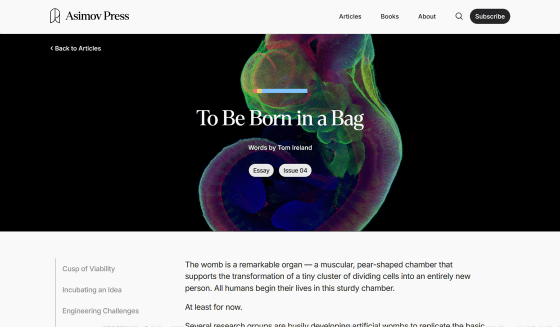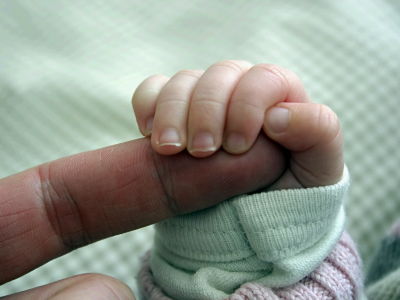Is an 'artificial womb' possible? What technical and ethical challenges would exist?

To be born in a bag
https://press.asimov.com/articles/artificial-wombs

Premature infant survival rate
Babies born before 37 weeks of pregnancy are considered premature, and extremely premature babies born before 28 weeks of pregnancy are said to be particularly difficult to care for. According to the World Health Organization, 900,000 people died in 2019 from complications related to premature birth. Even in the United States, where the medical standard is much higher than average, about one-third of newborns born before 24 weeks of pregnancy die, and newborns born at 22 weeks of pregnancy, which is said to be the limit for newborn survival, have only a 30% chance of surviving, and most of them have lifelong health problems.
The standard treatment for these extremely premature babies is to deliver oxygen to their lungs through a ventilation mask or a tube inserted in their windpipe, keep them warm with a heat lamp, and give them fluids and nutrients intravenously. But babies born so prematurely have lungs that are not ready to exchange gases, and even special low-pressure ventilators often cause irreparable damage to immature lung tissue.
Unlike these approaches, artificial wombs keep premature babies submerged in fluid, just like in a uterus, and remove carbon dioxide from their blood and provide oxygen to keep them alive. Devices vary in complexity, but they generally center around a heart-lung machine called extracorporeal membrane oxygenation (ECMO) . Placing a premature baby in a fluid-filled artificial womb also has the benefit of protecting the baby's fragile skin from exposure to the air, which can lead to infection.
In 2017, a research team at the Children's Hospital of Philadelphia in Pennsylvania announced that they had successfully raised a premature lamb for four weeks in a giant Ziploc-like artificial womb called the Biobag. The premature lamb used in the experiment had grown in its mother's uterus for 105 to 120 days, which is equivalent to a human fetus growing in its mother's womb for 22 to 24 weeks.
Successfully raised sheep fetus in artificial uterus 'Biobag' - GIGAZINE

Another approach being considered is to keep premature babies in a traditional incubator, rather than putting them in a fluid-filled bag, by connecting them to a miniature ECMO system and filling just the lungs with a special growth-stimulating fluid. This approach is not too different from existing systems, and may be easier for hospitals to adopt, Ireland said.
The History of Artificial Wombs
Although the term artificial womb may have a futuristic image, efforts to create one date back to the 1950s. In 1953, the first artificial heart-lung machine was used to deliver oxygen to patients undergoing cardiac surgery, and researchers began to explore other scenarios in which extracorporeal circulation could be used. From there, it was inevitable to arrive at the idea of 'sustaining the life of premature babies who cannot breathe on their own,' and in 1954 a patent was filed for an artificial womb that included a tank filled with amniotic fluid, a synthetic umbilical tail, a blood pump, an artificial kidney, and a water heater.
In 1954, a Swedish research team conducted early human experiments on an artificial womb using a 'viable human fetus' obtained from an aborted pregnant woman, connected to a simple circuit that oxygenated blood taken from a vein and returned it to the body. The fetus was reportedly able to survive for 5 to 12 hours by submerging it in an isotonic glucose solution that mimicked amniotic fluid. Although this human experiment has ethical challenges from a modern perspective, work on a similar device continued into the 1960s, and by 1969 a premature lamb was able to survive for more than 50 hours .
In addition, Colossal Biosciences (Colossal) , a biotechnology company aiming to revive the mammoth, plans to create hybrid embryos by combining mammoth DNA with Asian elephant stem cells in an in vitro development process using an artificial uterus from start to finish. At the time of writing, there was no precedent for an embryo growing into a fetus, so Colossal's goal is quite ambitious.

Technical challenges of artificial wombs
Although artificial wombs have already achieved some success in animal testing, there are various challenges to be overcome when applying them to premature human infants. Ireland points out that the biggest of these is 'making the artificial womb smaller.' Premature sheep babies around 105 to 120 days pregnant that have been used in artificial womb experiments so far are equivalent in developmental level to human fetuses at 22 to 23 weeks pregnant, but they weigh only 3.5 kg, which is not much different from a typical newborn. In contrast, premature human babies often weigh around 0.5 kg, so the size of the artificial womb must be smaller than that used for premature sheep babies.
To miniaturize the artificial uterus,
One of the challenges of connecting a premature baby to an artificial womb is that blood clots when it comes into contact with a foreign object. When using life support systems such as ECMO in general patients, anticoagulants such as heparin are administered to thin the blood, but using this on premature babies increases the risk of bleeding in the underdeveloped blood vessels in the brain. A promising solution is to use a polymer coating that releases nitric oxide, a natural anticoagulant, as blood passes through it, and its effectiveness was confirmed in a 2023 study using sheep.

And there are also challenges in transferring a premature baby to an artificial womb. When a baby takes its first breath, physiological changes occur in the body, but to maintain life in an artificial womb, this phenomenon must be avoided and factors such as changes in body temperature, exposure to air, light and loud noise must be taken into consideration. In animal experiments, the mother is given general anesthesia and a cesarean section is performed, and the fetus, injected with an opioid painkiller, is connected to ECMO with the umbilical tail still attached, and the umbilical tail is cut after normal blood flow is ensured. However, this method is very complicated and cannot be performed in an emergency or unexpected premature birth.
Researchers at the Eindhoven University of Technology in the Netherlands have begun modeling techniques for transferring a baby directly from the birth canal into a fluid-filled bag, or even pulling a baby delivered by Caesarean section directly into an artificial womb. In theory, this could allow the artificial womb to be used in a wider variety of premature birth scenarios, but the device would need to be connected to blood vessels in the fluid, making an already tricky procedure even more difficult.
'Regardless of which model works best, the fact remains that for healthcare professionals working in this field, transferring a baby into a sealed, fluid-filled system is an entirely new paradigm, one that could pose additional risks to both mother and baby,' Ireland noted.
Other problems include the complex immune and hormonal systems that a developing fetus receives from its mother in the womb, which are poorly understood and difficult to replicate in an artificial womb. Some researchers have acknowledged that their devices do not replicate the complex chemical environment of the womb, but are merely mechanical life support systems, and therefore use the term 'artificial placenta' rather than artificial womb.

Ethical issues surrounding artificial wombs
Following promising animal testing results for the Biobag, an artificial womb developed by a research team at the Children's Hospital of Philadelphia, the U.S. Food and Drug Administration (FDA)
Premature babies born after 24 weeks of gestation have a good chance of surviving even with conventional care, so it seems unethical to test clinical trials of an artificial womb whose effectiveness is unknown. On the other hand, premature babies born even earlier are more likely to suffer from complications such as infection and inflammation, and are less likely to survive even if connected to ECMO.
Complicating the issue is the fact that outcomes for premature babies vary widely, even within the United States. Some large hospitals have survival rates for premature babies at 22 weeks of gestation that are more than twice the national average, and some even keep babies alive at 21 weeks of gestation. This makes it difficult to create general guidelines for doctors to try artificial wombs.
Furthermore, if the fully artificial uterus developed by Colossal is realized, it will open up a new option to 'give birth to a child through a completely external development process' to those who cannot have children by any means other than surrogate birth due to diseases or disorders that affect the uterus. This is a hope, but it also raises various ethical issues, such as 'whether doctors will become de facto' creators of life ', 'what impact will it have on knowing that a child was born through an external development process, what impact will it have on women being liberated from their biological role in reproduction, and how do we deal with the risk of mass-producing soldiers and slaves by misusing the external development process.

Ireland pointed out that in vitro fertilization, which is now commonplace at the time of writing, was once considered a bizarre idea found in science fiction and was met with various concerns, but has now benefited millions of people. 'That may be the case in the future with artificial womb technology. The technical challenges that stand in the way of this technology remain significant, but many of them are likely to be resolved within the next few years,' said Ireland. 'Babies that are conceived and born outside of their mother's womb may be coming sooner than we think.'
Related Posts:
in Science, Posted by log1h_ik






